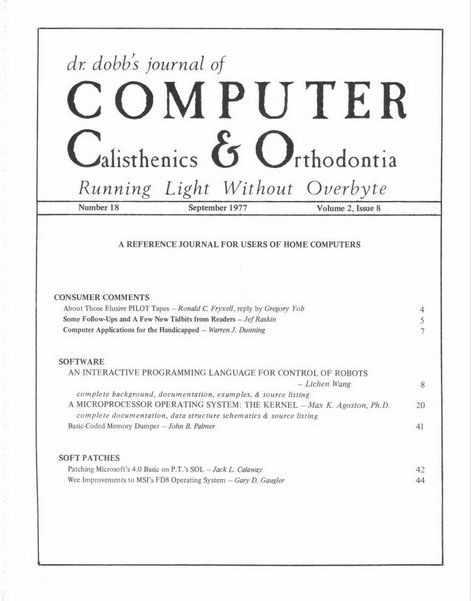
[author : Ronald C. Fryxell reply by Gregory Yob]
[author : Jef Raskin] #BASIC
Extract : « Thanxs to Ray Atnip for pointing out DEC’s use of PEEK and POKE (in BASIC under RT-11) before Micro Soft brought those useful extensions to personal computer land. I apologize to our readers and to DEC for missing this point. I do have a copy of DEC’s offerings of BASIC under RT-11 and (by way of proclaiming innocence) point out that the manuals do not mention PEEK and POKE. If a reader can send me a copy of a DEC manual with this information for my files I would appreciate it. I now have about 40 BASIC manuals including a mimeo’d one from Dartmouth back when BASIC was first invented. [...] »
[author : Warren J. Dunning]
Extract : « So, you finally got your computer up and running. What now? Have you spent a small fortune on your computer only to impress the neighbors or play Star Trek? How about putting your computer and your expertise in hardware design and/or programming to practical and worthwhile use? What about a project for your neighborhood computer club? The challenge is this: to develop computer-based systems to aid the handicapped. The microprocessor makes possible many devices that were only dreams several years ago. [...] »
[author : Lichen Wang] #Languages #Robotics #Listing #Assembly
Extract : « This is a simple-minded “Tiny” language. The basic idea is to use an ASCII keyboard as the command input device for a microprocessor controlled robot. Rudimentary commands consisting of a single ASCII character are executed by the robot as soon as they are typed. Some primitive forms of IF-THEN-ELSE, REPEAT-n-TIMES, and run-time-macro are included. Paired parentheses are used to group any number of commands into a single command and enable one to construct complex structures. The run-time-macro is probably the most important feature that makes a simple language such as this one powerful and easy to use.
This language is open-ended and is not limited to any specific robot. To illustrate this point, a version of this language is implemented on an 8080-based microprocessor to control a robot who has a “mind” but no “body”. Later in this article, two different “bodies” are attached to the robot’s “mind” as examples. Revisions and implementations on other microprocessors can be made if there are such interests. [...] »
[author : Max K. Agoston, Ph.D.] #OperatingSystem #HowItWorks
Extract : « This article describes in detail the kernel for a real-time interactive multiprocess operating system (RIMOS for short). RIMOS was intended to extend the INTEL MDS system and because of this the kernel subroutines make use of INTEL’S ISIS. (The INTEL monitor was used only at the start to load ISIS.) However, the source code that will be listed later is basically usable on any computer using the INTEL 8080 microprocessor, except that one would have to write a file system and make some simple changes to eliminate reference to ISIS. [...]
1. E. W. Dijkstra, “The structure of the ‘THE’ — Multiprogramming System”, Comm. ACM 11(5) 1968,341-346.
2. K. Donovan and S. Madnick, Operating Systems, McGraw-Hill Book Co., New York, 1974.
3. P. Brinch Hansen, Operating System Principles, Prentice-Hall, Inc., New Jersey, 1973.
4. B. H. Liskov, “The design of the Venus operating system”, Comm. ACM 15(3) 1972, 144-149.
5. D. M. Ritchie and K. Thompson, “The UNIX timesharing system”, Comm. ACM 17(7) 1974, 365-375.
6. A. C. Shaw, The Logical Design of Operating Systems, Prentice-Hall, Inc., New Jersey, 1974.
7. D. C. Tsichritzis and P. A. Bernstein, Operating Systems, Academic Press, New York, 1974.
8. R. Watson, Timesharing System Design Concepts, McGraw-Hill Book Co., New York, 1970.
9. Operating Systems Survey, the Comtre Corp., editor: A. P. Sayers, Auerbach Publ. Inc., 1971. »
[author : John B. Palmer] #BASIC #Listing #Programming #Diagnostic
Extract : « Gentlemen;
Enclosed is a program that i enjoyed writing and just maybe someone else might tike it. I am a long-time 'ham' just now turned computer hobbyist. I have an Altair 880B with 16K, and audio cassette and a KSR-33 Teletype.
I like to PEEK and POKE into Basic. Without a memory dump it is hard to know what is going on. The PEEK feature of Basic gives values in decimal, I wanted a dump in octal so I wrote the enclosed program.
This program, written in MITS 8K Basic, will give a octal or decimal printed page for any section of memory within the range of Basic’s PEEK statement. [...] »
[author : Jack L. Calaway] #Basic
Extract : « Just a quick note to pass along a couple of things. First, the kudos and brickbats. The good guys; Dr. Dobbs, your publication is the most interesting of all the “home computing” publications. Xybek, and their PROM programming board, a good product with excellent documentation, and people with a genuine desire to help their customers, Micro-Chess, a super chess playing program, with good documentation and priced fairly. The bad guys; the multitude of manufacturers who have promised so much, and have delivered so little, (IMSAI, where’s the 12K BASIC, Processor Tech, where’s the 8K BASIC so long overdue?).
Attached are the patches I made for a friend so he could use his Altair BASIC on his new Sol. [...] »